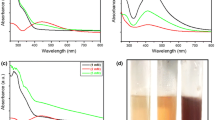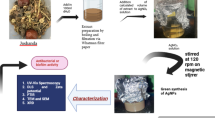Abstract
In this study, silver@graphene oxide nanocomposites (Ag@GO NCs) derived from extracts of Antarctic lichens Usnea antarctica and Umbilicaria antarctica were synthesized and their antimicrobial activity against to fish pathogen bacteria were evaluated. According to the results of characterization test, spherical Ag NPs were well dispersed on the surface of graphene oxide. While the diameters of Usnea antartica extract-based NCs were observed at an average of 28 nm, the diameters of Umbilica antartica extract-based NCs were found 40 nm. The absorption points of Usnea antartica and Umbilicaria antartica extract-based Ag@GO NCs were detected at 445 nm. The highly stable structures of NCs synthesized with both lichen extracts were exhibited with zeta potential. In addition, functional groups that play a role in the synthesis were revealed by FT-IR analysis and its crystal structure was revealed by XRD analysis. The lichen-based NCs have excellent antimicrobial activity against to Staphylococcus aureus, Aeromonas hydrophila, Pseudomonas aeruginosa, and Yersinia ruckeri strains. As a result, we suggest that Ag@GO NCs were synthesized with both lichen extracts by an effective, inexpensive, and eco-friendly method and are applicable for antimicrobial activity studies.










Similar content being viewed by others
Data availability
Data are available on request from the authors.
References
Ahamed M, Akhtar MJ, Khan MAM, Alhadlaq HA (2022) A novel green preparation of Ag/RGO nanocomposites with highly effective anticancer performance. Polymers 13:3350. https://doi.org/10.3390/polym13193350
Ahmad MA, Aslam S, Mustafa F, Arshad U (2021) Synergistic antibacterial activity of surfactant free Ag–GO nanocomposites. Sci Rep 11:196. https://doi.org/10.1038/s41598-020-80013-w
Akintelu SA, Olugbeko SC, Folorunso AS, Oyebamiji AK, Folorunso FA (2021) Potentials of phytosynthesized silver nanoparticles in biomedical fields: a review. Int Nano Lett 11:273–293. https://doi.org/10.1007/s40089-021-00341-1
Bafghi MH, Safdari H, Darroudi M, Sabouri Z, Zargar M, Zarrinfar H (2021) Evaluation and comparison of the effects of biosynthesized selenium and silver nanoparticles using plant extracts with antifungal drugs on the growth of Aspergillus and Candida species. Rend Lincei Sci Fis Nat 32:791–880. https://doi.org/10.1007/s12210-021-01021-0
Bjerke JW, Dahl T (2002) Distribution patterns of usnic acid-producing lichens along local radiation gradients in West Greenland. Nova Hedwigia 75:487–506. https://doi.org/10.1127/0029-5035/2002/0075-0487
Bjerke JW, Joly D, Nilsen L, Brossard T (2004) Spatial trends in usnic acid concentrations of the lichen Flavocetraria nivalis along local climatic gradients in the Arctic (Kongsfjorden, Svalbard). Polar Biol 27:409–417. https://doi.org/10.1007/s00300-004-0590-8
Dut Jasuja N, Kumar Gupta D, Reza M, Joshi SC (2014) Green Synthesis of AgNPs stabilized with biowaste and their antimicrobial activities. Braz J Microbiol 45:1325–1332. https://doi.org/10.1590/S1517-83822014000400024
Emima Jeronsia J, Ragu R, Jerline Mary A, Jerome Das S (2021) Elucidating the structural, anticancer, and antibacterial traits of Punica granatum peel extracts-mediated Ag and Ag/GO nanocomposites. Microsc Res Tech 85:44–55. https://doi.org/10.1002/jemt.23883
Gautam S, Singh J, Pant AB (2011) Effect of UV-B radiations on the pigments of two Antarctic lichens of Schirmacher Oasis, East Antarctica. Polar Res 32:279–287. https://doi.org/10.2478/v10183-011-0019-3
Ghaedi M, Yousefinejad M, Safarpoor M, Khafri HZ, Purkait MK (2015) Rosmarinus officinalis leaf extract mediated green synthesis of silver nanoparticles and investigation of its antimicrobial properties. J Ind Eng Chem 25:167–172. https://doi.org/10.1016/j.jiec.2015.06.020
González-Ballesteros N, González-Rodríguez JB, Rodríguez-Argüelles MC, Lastra M (2018) New application of two Antarctic macroalgae Palmaria decipiens and Desmarestia menziesii in the synthesis of gold and silver nanoparticles. Polar Sci 15:49–54. https://doi.org/10.1016/j.polar.2017.10.004
Hassan AMS, Mahmoud AS, Ramadan MF, Eissa MA (2022) Microwave-assisted green synthesis of silver nanoparticles using Annona squamosa peels extract: characterization, antioxidant, and amylase inhibition activities. Rend Fis Acc Lincei 33:83–91. https://doi.org/10.1007/s12210-022-01049-w
Heydari R, Rashidipour M (2015) Green synthesis of silver nanoparticles using extract of oak fruit hull (jaft): Synthesis and ın vitro cytotoxic effect on MCF-7 cells. Int J Breast Cancer 2015:846743. https://doi.org/10.1155/2015/846743
Hooda F, Sharma M (2020) Green synthesis, characterization and antibacterial activity of ıron oxide nanoparticles. Plant Arch 20:1196–1200
Jadoun S, Arif R, Jangid NK, Meena RK (2021) Green synthesis of nanoparticles using plant extracts: a review. Environ Chem Lett 19:355–374. https://doi.org/10.1007/s10311-020-01074-x
Kaplan Ö, Gökşen Tosun N, Özgür A, Erden Tayhan S, Bilgin S, Türkekul İ, Gökce İ (2021) Microwave-assisted green synthesis of silver nanoparticles using crude extracts of Boletus edulis and Coriolus versicolor: Characterization, anticancer, antimicrobial and wound healing activities. J Drug Deliv Sci Technol 64:102641. https://doi.org/10.1016/j.jddst.2021.102641
Kappen L (2000) Some aspects of the great success of lichens in Antarctica. Antarct Sci 12:314–324. https://doi.org/10.1017/S0954102000000377
Khan I, Saeed K, Khan I (2019) Nanoparticles: Properties, applications and toxicities. Arab J Chem 12:908–931. https://doi.org/10.1016/j.arabjc.2017.05.011
Liu L, Liu J, Wang Y, Yan X, Sun DD (2011) Facile synthesis of monodispersed silver nanoparticles on graphene oxide sheets with enhanced antibacterial activity. New J Chem 35:1418–1423. https://doi.org/10.1039/C1NJ20076C
Liu CC, Xu H, Wang L, Qin X (2017) Facile one-pot green synthesis and antibacterial activities of GO/Ag Nanocomposites. Acta Metal Sin-Engl 30:36–44. https://doi.org/10.1007/s40195-016-0517-8
Lorestani F, Shahnavaz Z, Alias MP, Y, Manan NSA, (2015) One-step hydrothermal green synthesis of silver nanoparticle-carbon nanotube reduced-graphene oxide composite and its application as hydrogen peroxide sensor. Sens Actuators B Chem 208:389–398. https://doi.org/10.1016/j.snb.2014.11.074
Lud D, Huiskes AHL, Moerdijk TCW, Rozema J (2001) The effects of altered levels of UV-B radiation on an Antarctic grass and lichen. İn: Rozema J, Manetas Y, Björn LO (eds) Responses of plants to UV-B radiation. Advances in vegetation science, Springer, Dordrecht. https://doi.org/10.1007/978-94-017-2892-8_9
Ma J, Zhang J, **ong Z, Young Y, Zhao XS (2011) Preparation, characterization and antibacterial properties of silver-modified graphene oxide. J Mater Chem 21:3350–3352. https://doi.org/10.1039/C0JM02806A
McEvoy M, Nybakken L, Solhaug KA, Gauslaa Y (2006) UV triggers the synthesis of the widely distributed secondary compound usnic acid. Mycol Prog 5:221–229. https://doi.org/10.1007/s11557-006-0514-9
McEvoy M, Solhaug KA, Gauslaa Y (2007) Solar radiation screening in usnic acid containing cortices of the lichen Nephroma arcticum. Symbiosis 43:143–150
Meng Y (2015) A sustainable approach to fabricating Ag nanoparticles/PVA hybrid nanofiber and ıts catalytic activity. Nanomaterials 5:1124–1135. https://doi.org/10.3390/nano5021124
Moteriya P, Chanda S (2020) Green synthesis of silver nanoparticles from Caesalpinia pulcherrima leaf extract and evaluation of their antimicrobial, cytotoxic and genotoxic potential (3-in-1 system). J Inorg Organomet Polym 30:3920–3932. https://doi.org/10.1007/s10904-020-01532-7
Nazari F, Jafarirad S, Movafeghi A, Kosari-Nasab M, Mohajel Kazemi E (2020) Toxicity of microwave-synthesized silver reduced graphene oxide nanocomposites to the microalga Chlorella vulgaris: Comparison with the hydrothermal method synthesized counterparts. J Environ Sci Health Part A 55:639–649. https://doi.org/10.1080/10934529.2020.1726142
Ocsoy I, Temiz M, Celik C, Altinsoy B, Yilmaz V, Duman F (2017) A green approach for formation of silver nanoparticles on magnetic graphene oxide and highly effective antimicrobial activity and reusability. J Mol Liq 227:147–152. https://doi.org/10.1016/j.molliq.2016.12.015
Potbhare AK, Umekar MS, Chouke PB, Bagade MB, Tarik Aziz SK, Abdala AA, Chaudhary RG (2020) Bioinspired graphene-based silver nanoparticles: fabrication, characterization and antibacterial activity. Mater Today Proc 29:720–725. https://doi.org/10.1016/j.matpr.2020.04.212
Princy KF, Gopinath A (2021) Green synthesis of silver nanoparticles using polar seaweed Fucus gardeneri and its catalytic efficacy in the reduction of nitrophenol. Polar Sci 30:100692. https://doi.org/10.1016/j.polar.2021.100692
Rohaizad A, Shahabuddin S, Shahid MM, Rashid NM, Hir ZAM, Ramly MM, Awang K, Siong CW, Aspanut Z (2020) Green synthesis of silver nanoparticles from Catharanthus roseus dried bark extract deposited on graphene oxide for effective adsorption of methylene blue dye. J Environ Chem Eng 8:103955. https://doi.org/10.1016/j.jece.2020.103955
Sahu D, Sarkar N, Sahoo G, Mohapatra P, Swain SK (2015) Silver ımprinted graphene nanocomposites: synthesisis and morphological study. Appl Sci Adv Mat Int 1:224–227
Schroeter B, Scheidegger C (1995) Water relations in lichens at subzero temperatures: structural changes and carbon dioxide exchange in the lichen Umbilicaria aprina from continental Antarctica. New Phytol 131:273–285. https://doi.org/10.1111/j.1469-8137.1995.tb05729.x
Solhaug KA, Gauslaa Y (2012) Secondary lichen compounds as protection against excess solar radiation and herbivores. In: Lüttge U, Beyschlag W, Büdel B, Francis D (eds) Progress in botany 73. Springer, Berlin, Heidelberg, pp 283–304
Swanson A, Fahselt D, Smith D (1996) Phenolic levels in Umbilicaria americana in relation to enzyme polymorphism, altitude and sampling date. Lichenologist 28:331–339. https://doi.org/10.1006/lich.1996.0030
Thomas R, Unnikrishnan J, Nair AV, Daniel EC, Balachandran M (2020) Antibacterial performance of GO-Ag nanocomposite prepared via ecologically safe protocols. Appl Nanosci 10:4207–4219. https://doi.org/10.1007/s13204-020-01539-z
Turunc E, Kahraman O, Binzet R (2021) Green synthesis of silver nanoparticles using pollen extract: characterization, assessment of their electrochemical and antioxidant activities. Anal Biochem 621:114123. https://doi.org/10.1016/j.ab.2021.114123
Vanlalveni C, Lallianrawna S, Biswas A, Selvaraj M, Changmai B, Rokhum SL (2021) Green synthesis of silver nanoparticles using plant extracts and their antimicrobial activities: a review of recent literature. RSC Adv 11:2804–2837. https://doi.org/10.1039/D0RA09941D
Vatne S, Asplund J, Gauslaa Y (2011) Contents of carbon based defence compounds in the old forest lichen Lobaria pulmonaria vary along environmental gradients. Fungal Ecol 4:350–355. https://doi.org/10.1016/j.funeco.2011.03.007
Wang Y, Chinnathambi O, Nasif O, Ali A (2021) Green synthesis and chemical characterization of a novel anti-human pancreatic cancer supplement by silver nanoparticles containing Zingiber officinale leaf aqueous extract. Arab J Chem 14:103081. https://doi.org/10.1016/j.arabjc.2021.103081
Wierzbicki M, Jaworski S, Sawosz E, Jung A, Gielerak G, Jaremek H, Łojkowski W, Woźniak B, Stobiński L, Małolepszy A, Chwalibog A (2019) Graphene oxide in a composite with silver nanoparticles reduces the fibroblast and endothelial cell cytotoxicity of an antibacterial nanoplatform. Nanoscale Res Lett 14:320. https://doi.org/10.1186/s11671-019-3166-9
Wu T, Liu S, Luo Y, Lu W, Wang L, Sun X (2011) Surface plasmon resonance-induced visible light photocatalytic reduction of graphene oxide: Using Ag nanoparticles as a plasmonic photocatalyst. Nanoscale 3:2142–2144. https://doi.org/10.1039/C1NR10128E
Yaqoob AA, Umar K, Ibrahim MNM (2020) Silver nanoparticles: various methods of synthesis, size affecting factors and their potential applications–a review. Appl Nanosci 10:1369–1378. https://doi.org/10.1007/s13204-020-01318-w
Zamarchi F, Vieira IC (2021) Determination of paracetamol using a sensor based on green synthesis of silver nanoparticles in plant extractJ. Pharm Biomed Anal 196:113912. https://doi.org/10.1016/j.jpba.2021.113912
Zhu J, Ni H, Hu C, Zhu Y, Cai J, Liu S, Gao J, Yang H, Liu H (2021) Rapid synthesis and characterization of silver-loaded graphene oxide nanomaterials and their antibacterial applications. R Soc Open Sci 8:201744. https://doi.org/10.1098/rsos.201744
Acknowledgements
This study is supported by TÜBİTAK 118Z587 coded project.
Author information
Authors and Affiliations
Contributions
F.D.K. ssynthesized and characterized nanoparticles, wrote the main manuscript, prepared figures M.G.H. collected and obtained extract of lichen samples, wrote the main manuscript AD. synthesized and characterized nanoparticles, study antimicrobial activity, wrote the main manuscript İÖ. synthesized and characterized nanoparticles All authors reviewed the manuscript.
Corresponding author
Ethics declarations
Conflict of interest
The authors have declared that no competing interests exist.
Additional information
Publisher's Note
Springer Nature remains neutral with regard to jurisdictional claims in published maps and institutional affiliations.
Rights and permissions
Springer Nature or its licensor (e.g. a society or other partner) holds exclusive rights to this article under a publishing agreement with the author(s) or other rightsholder(s); author self-archiving of the accepted manuscript version of this article is solely governed by the terms of such publishing agreement and applicable law.
About this article
Cite this article
Koca, F.D., Demırbas, A., Halıcı, M.G. et al. Bio-synthesis of graphene oxide-decorated silver nanocomposites using Usnea antarctica and Umbilicaria antarctica from Antarctic Peninsula and evaluation of their antimicrobial activities. Rend. Fis. Acc. Lincei 35, 513–522 (2024). https://doi.org/10.1007/s12210-024-01246-9
Received:
Accepted:
Published:
Issue Date:
DOI: https://doi.org/10.1007/s12210-024-01246-9




